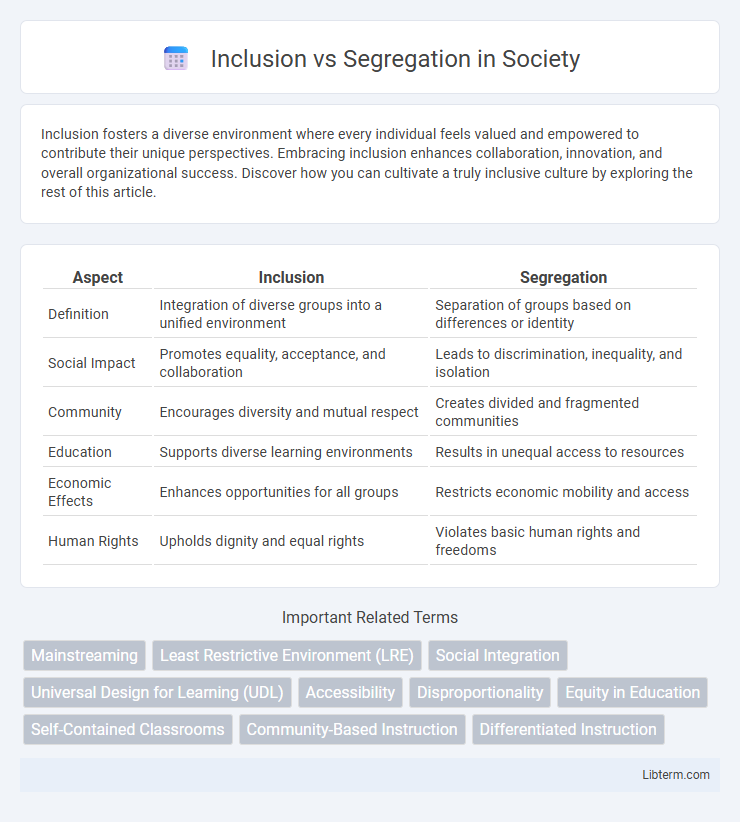Inclusion fosters a diverse environment where every individual feels valued and empowered to contribute their unique perspectives. Embracing inclusion enhances collaboration, innovation, and overall organizational success. Discover how you can cultivate a truly inclusive culture by exploring the rest of this article.
Table of Comparison
| Aspect | Inclusion | Segregation |
|---|---|---|
| Definition | Integration of diverse groups into a unified environment | Separation of groups based on differences or identity |
| Social Impact | Promotes equality, acceptance, and collaboration | Leads to discrimination, inequality, and isolation |
| Community | Encourages diversity and mutual respect | Creates divided and fragmented communities |
| Education | Supports diverse learning environments | Results in unequal access to resources |
| Economic Effects | Enhances opportunities for all groups | Restricts economic mobility and access |
| Human Rights | Upholds dignity and equal rights | Violates basic human rights and freedoms |
Understanding Inclusion and Segregation
Inclusion refers to educational practices that integrate all students, regardless of their abilities or backgrounds, into mainstream classrooms, promoting equal access and participation. Segregation separates students with disabilities or differing needs into specialized settings, which can limit social interaction and equitable learning opportunities. Understanding the distinctions helps educators develop policies that foster diversity, equity, and social cohesion within schools.
Historical Context of Educational Approaches
The historical context of educational approaches to inclusion versus segregation reveals that segregation was institutionalized through policies like Jim Crow laws and the "separate but equal" doctrine established by the 1896 Plessy v. Ferguson Supreme Court decision. The Civil Rights Movement and landmark rulings such as Brown v. Board of Education in 1954 challenged these practices by declaring segregated schools inherently unequal, paving the way for inclusive education models. Despite legal mandates, systemic barriers persisted, and ongoing efforts focus on fully integrating students with disabilities and diverse racial backgrounds into general education classrooms to promote equity and social cohesion.
Key Principles of Inclusive Practices
Inclusive practices emphasize the key principles of equitable access, respect for diversity, and active participation for all individuals regardless of ability or background. These principles promote collaboration, personalized support, and the removal of barriers within educational and social environments. By fostering a culture of acceptance and belonging, inclusive practices ensure that everyone benefits from shared opportunities and resources.
Characteristics of Segregated Settings
Segregated settings are characterized by the physical and social isolation of individuals with disabilities from their non-disabled peers, often resulting in limited access to general education curricula and social interactions. These environments typically have specialized staff and resources tailored exclusively to specific disabilities, but lack opportunities for inclusion in mainstream activities. The focus in segregated settings is often on remediation rather than fostering integration, which can impact social development and hinder community participation.
Social and Emotional Impacts
Inclusion fosters a sense of belonging, enhancing social connections and emotional well-being by allowing individuals to engage meaningfully with diverse peers. Segregation often leads to isolation, limiting opportunities for social interaction and contributing to feelings of loneliness and decreased self-esteem. Research shows inclusive environments promote empathy, reducing social stigmas and supporting positive identity development.
Academic Outcomes Comparison
Inclusion in education promotes diverse classrooms where students with disabilities learn alongside their peers, leading to improved academic outcomes such as higher literacy and math scores. Segregation often limits access to grade-level content, resulting in lower academic achievement and reduced social skills development. Research shows inclusive settings foster engagement and motivation, supporting better long-term educational success for all students.
Legal and Policy Frameworks
Legal frameworks such as the Individuals with Disabilities Education Act (IDEA) mandate inclusive education by requiring public schools to provide free appropriate public education in the least restrictive environment. Policy frameworks promote inclusion by emphasizing equal access, nondiscrimination, and the integration of students with disabilities into mainstream classrooms alongside their peers. Segregation policies, often rooted in outdated or discriminatory laws, separate students based on disability or other characteristics, limiting access to general education and social opportunities.
Challenges in Implementing Inclusion
Challenges in implementing inclusion include addressing diverse learner needs within a single classroom while providing adequate resources and training for educators. Resistance from stakeholders and systemic barriers often hinder the effective integration of students with disabilities or different backgrounds. Inclusive education demands continuous adaptation of curriculum, teaching methods, and assessment to ensure equity and participation for all students.
Strategies for Fostering Inclusive Environments
Implementing Universal Design for Learning (UDL) principles ensures accessibility and engagement for all students by addressing diverse learning styles and abilities. Collaborative teaching models, such as co-teaching, promote shared responsibility and tailored support within inclusive classrooms. Professional development focused on cultural competence and anti-bias training equips educators to create respectful and supportive environments that celebrate diversity and reduce segregation.
Future Trends in Education: Inclusion vs Segregation
Future trends in education emphasize the expansion of inclusive practices that integrate students with diverse learning needs into mainstream classrooms, supported by adaptive technologies and personalized learning plans. Research indicates that inclusive education promotes social cohesion, improves academic outcomes, and prepares students for diverse workplaces. Conversely, segregation models face increasing criticism for limiting opportunities and perpetuating inequalities, driving policy shifts towards more equitable and accessible educational environments.
Inclusion Infographic

 libterm.com
libterm.com